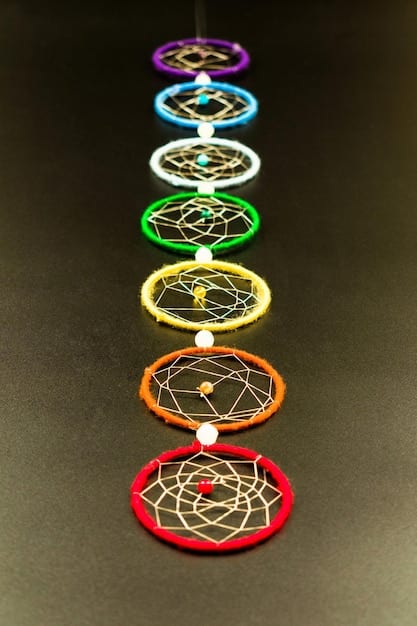Chakra Meditation: A Beginner’s Guide to Energy Balance

Chakra meditation is a practice that involves focusing on the seven main energy centers in the body to promote balance, healing, and overall well-being, making it an accessible and effective method for beginners to improve their physical and mental health.
Embark on a journey to inner peace and enhanced well-being with chakra meditation, a powerful technique for balancing your energy centers. This beginner’s guide will provide you with the essential knowledge and practical steps to harness the benefits of chakra meditation today.
Understanding Chakra Meditation
Chakra meditation is an ancient practice rooted in Hindu and Buddhist traditions. It focuses on the seven major chakras, or energy centers, within the body, each associated with specific aspects of our physical, emotional, and spiritual health. By learning to balance these energy centers through meditation, you can enhance your overall well-being.
Each chakra is believed to influence different aspects of your life, and imbalances in these centers can lead to physical, emotional, or spiritual issues. Chakra meditation aims to restore harmony by clearing blockages and promoting the free flow of energy.
The Seven Chakras
Understanding the location and function of each chakra is crucial for effective meditation. Here’s a brief overview:
- Root Chakra (Muladhara): Located at the base of the spine, it governs feelings of safety, security, and survival.
- Sacral Chakra (Swadhisthana): Situated in the lower abdomen, it relates to creativity, pleasure, and sexuality.
- Solar Plexus Chakra (Manipura): Found in the upper abdomen, it’s associated with personal power, confidence, and self-esteem.
- Heart Chakra (Anahata): Located in the center of the chest, it governs love, compassion, and emotional balance.
- Throat Chakra (Vishuddha): Situated in the throat, it relates to communication, self-expression, and truth.
- Third Eye Chakra (Ajna): Found between the eyebrows, it’s associated with intuition, insight, and spiritual awareness.
- Crown Chakra (Sahasrara): Located at the top of the head, it governs spiritual connection, enlightenment, and universal consciousness.
By focusing on each of these chakras during meditation, you can identify areas of imbalance and work towards restoring harmony within yourself. This mindful practice can lead to significant improvements in both your physical and mental well-being.
In conclusion, understanding chakra meditation involves recognizing the importance of the seven chakras and their influence on your overall health. By focusing on these energy centers, you can begin to unlock a path to balance and well-being. This initial understanding is a crucial foundation for a more profound and beneficial meditation practice.
Preparing for Chakra Meditation
Before diving into chakra meditation, it’s essential to create a conducive environment and mindset. Preparation is key to ensuring a focused and effective meditation session. This includes setting the right atmosphere, understanding the best time to meditate, and adopting a comfortable posture.
Creating the right environment can significantly impact your ability to relax and focus. By taking the time to prepare, you set the stage for a more profound and beneficial meditation experience.
Creating a Peaceful Environment
Find a quiet space where you won’t be disturbed. Dim the lights or use candles to create a calming atmosphere. You can also add elements like soft music, incense, or essential oils to enhance relaxation.
Optimal Timing for Meditation
Many practitioners find that meditating in the morning or evening is most effective. Morning meditation can set a positive tone for the day, while evening meditation can help you unwind and release stress. Experiment to find the time that works best for you.
Comfortable Posture Tips
Sit in a comfortable position. This could be on a cushion on the floor, in a chair with your feet flat on the ground, or even lying down. The most important thing is to maintain a straight spine to allow energy to flow freely.
- Cushion Support: Use a cushion or pillow to support your hips and maintain a comfortable posture.
- Chair Meditation: If sitting on the floor is uncomfortable, sit in a chair with your feet flat on the ground and your back straight.
- Relaxation Techniques: Practice deep breathing exercises to relax your body and mind before starting your meditation.
In essence, preparing for chakra meditation involves creating a sacred space, choosing an optimal time, and adopting a comfortable posture. These preliminary steps are crucial for setting the stage for a focused and fruitful meditation session, enabling you to connect more deeply with your inner self and balance your energy centers.

Basic Chakra Meditation Techniques
Now that you’ve prepared your environment and mindset, let’s explore some basic techniques for chakra meditation. These methods are designed to help you focus on each chakra individually, promoting balance and energy flow. There are several approaches you can take, depending on your personal preferences and goals.
Mastering these basic techniques is a fundamental step towards achieving a deeper understanding of your chakras and harnessing the benefits of chakra meditation.
Visualization Technique
Imagine each chakra as a spinning wheel of energy, visualizing its corresponding color. For example, the root chakra is red, the sacral chakra is orange, and so on.
Mantra Repetition Method
Chant the seed mantra associated with each chakra. These mantras, known as Bija mantras, are single-syllable sounds that resonate with the energy of each chakra. For example, the root chakra mantra is “Lam,” and the sacral chakra mantra is “Vam.”
Guided Chakra Meditation
Follow a guided meditation led by an experienced practitioner. These meditations typically involve visualizations, affirmations, and breathing exercises designed to activate and balance each chakra.
- Breathing Exercises: Incorporate specific breathing techniques, such as alternate nostril breathing, to enhance energy flow.
- Affirmations: Use positive affirmations related to each chakra to reinforce balance and well-being. For example, for the heart chakra, you might affirm, “I am open to giving and receiving love.”
- Focus on Sensations: Pay attention to any sensations you feel in the area of each chakra, acknowledging and releasing any tension or discomfort.
To summarize, basic chakra meditation techniques include visualization, mantra repetition, and guided meditations. Regularly practicing these techniques can lead to improved energy flow and a greater sense of balance and well-being. It’s essential to approach these practices with patience and consistency, allowing yourself to gradually deepen your connection with each chakra.
Deeper Dive into Each Chakra
To truly understand and balance your energy centers, it’s beneficial to delve deeper into each chakra individually. This involves understanding its location, color, associated emotions, and how to identify imbalances. By focusing on each chakra in isolation, you can develop a more profound connection and tailor your meditation to address specific needs.
This comprehensive approach will enable you to fine-tune your chakra meditation practice and achieve more targeted and effective results, addressing specific emotional and physical needs.
Root Chakra (Muladhara)
Located at the base of the spine, this chakra is associated with feelings of survival, security, and grounding. Its color is red. Imbalances can manifest as anxiety, fear, or feelings of insecurity.
Sacral Chakra (Swadhisthana)
Situated in the lower abdomen, this chakra governs creativity, pleasure, and sexuality. Its color is orange. Imbalances may result in emotional instability, lack of creativity, or relationship issues.
Solar Plexus Chakra (Manipura)
Found in the upper abdomen, this chakra is linked to personal power, confidence, and self-esteem. Its color is yellow. Imbalances can lead to low self-esteem, lack of motivation, or digestive issues.
- Heart Chakra (Anahata): Located in the center of the chest, it governs love, compassion, and emotional balance. Its color is green. Imbalances can manifest as difficulty in relationships, loneliness, or emotional detachment.
- Throat Chakra (Vishuddha): Situated in the throat, this chakra relates to communication, self-expression, and truth. Its color is blue. Imbalances may result in difficulty expressing oneself, fear of speaking up, or communication problems.
- Third Eye Chakra (Ajna): Found between the eyebrows, this chakra is associated with intuition, insight, and spiritual awareness. Its color is indigo. Imbalances can lead to lack of intuition, difficulty concentrating, or a closed-minded perspective.
To conclude, delving deeper into each chakra involves understanding its specific attributes and how imbalances can manifest. By recognizing these nuances, you can tailor your meditation practice to address particular needs, fostering a more balanced and harmonious state of being. This deeper understanding allows for a more targeted and effective approach to chakra meditation.

Incorporating Chakra Meditation into Your Daily Routine
Integrating chakra meditation into your daily routine can significantly enhance its benefits. Consistency is key to experiencing long-term improvements in your physical, emotional, and spiritual well-being. Even a few minutes of daily practice can make a substantial difference.
Making chakra meditation a regular part of your life can lead to increased self-awareness, improved emotional resilience, and a greater sense of overall well-being. Start small, stay consistent, and enjoy the journey to inner balance.
Setting Realistic Goals
Start with a manageable goal, such as meditating for 5-10 minutes each day. Gradually increase the duration as you become more comfortable with the practice.
Combining with Other Practices
Enhance your chakra meditation practice by combining it with other wellness activities, such as yoga, deep breathing exercises, or mindful walking.
Mindfulness Integration
Incorporate mindfulness into your daily activities. Pay attention to your thoughts and emotions as they arise, and use chakra meditation techniques to address any imbalances.
- Morning Ritual: Begin your day with a short chakra meditation to set a positive intention and balance your energy.
- Evening Practice: Use evening meditation to release stress and prepare for restful sleep, focusing on calming and grounding chakras.
- Breaks During the Day: Take short breaks throughout the day to check in with your chakras and address any imbalances that may arise.
In summary, incorporating chakra meditation into your daily routine involves setting realistic goals, combining it with other wellness practices, and integrating mindfulness into your daily activities. Consistency is crucial for experiencing the long-term benefits of chakra meditation. By making it a regular part of your life, you can cultivate a greater sense of balance, well-being, and inner peace.
Troubleshooting Common Challenges
As with any new practice, you may encounter challenges when beginning chakra meditation. Common issues include difficulty focusing, distractions, and physical discomfort. However, with patience and persistence, these challenges can be overcome, and you can continue to deepen your meditation practice.
By addressing these challenges head-on, you can create a smoother and more enjoyable meditation experience, allowing you to fully harness the benefits of chakra meditation and achieve a greater sense of inner balance.
Difficulty Focusing
If you find it hard to concentrate, try using a focal point, such as a candle flame or a specific object. You can also try guided meditations, which can help keep your mind engaged.
Dealing with Distractions
Acknowledge any distractions that arise, but gently redirect your focus back to your breath or the chakra you are working with. Don’t judge yourself for becoming distracted; simply recognize it and return to your practice.
Managing Physical Discomfort
Adjust your posture to find a more comfortable position. You can also use props, such as cushions or blankets, to support your body. If discomfort persists, try meditating for shorter periods.
- Mindful Breathing: Practice deep, mindful breathing to calm your mind and reduce distractions during meditation.
- Body Awareness: Pay attention to your body and make adjustments as needed to alleviate any physical discomfort.
- Consistent Practice: Continue practicing regularly, even if you experience challenges. Over time, you will develop greater focus and resilience.
In conclusion, troubleshooting common challenges in chakra meditation involves addressing difficulty focusing, dealing with distractions, and managing physical discomfort. By implementing these strategies and maintaining a consistent practice, you can overcome obstacles and continue to deepen your meditation journey. Patience and persistence are key to unlocking the full benefits of chakra meditation.
| Key Point | Brief Description |
|---|---|
| 🧘♀️ Chakra Meditation | Balance energy centers for well-being. |
| 🧘♂️ Preparation | Create a peaceful environment and comfortable posture. |
| 🌈 Techniques | Use visualization, mantras, or guided meditations. |
| 🌱 Daily Routine | Incorporate meditation for consistent benefits. |
Frequently Asked Questions
▼
Many find morning or evening ideal. Morning meditation can set a positive tone, while evening meditation helps unwind and reduce stress. Experiment to find what works best for you.
▼
Start with 5-10 minutes per chakra and gradually increase as you become comfortable. The total meditation time can vary from 35 to 70 minutes, depending on your preference.
▼
Yes, you can meditate on all chakras in one session. Focus on each chakra individually for a few minutes, moving from the root chakra to the crown chakra, to balance your entire energy system.
▼
If visualizing is challenging, focus on the sensations in the area of each chakra. You can also use guided meditations or look at images of the chakras to help with visualization.
▼
Consistency is key. Aim to practice chakra meditation daily or at least several times a week. With regular practice, you should start to notice improvements in your overall well-being.
Conclusion
In conclusion, chakra meditation offers a powerful pathway to enhanced well-being by balancing the body’s energy centers. By understanding and applying the techniques outlined in this guide, beginners can start their journey towards inner peace, emotional stability, and improved physical health. Consistent practice and mindfulness will unlock the full potential of chakra meditation, leading to a more balanced and harmonious life.





